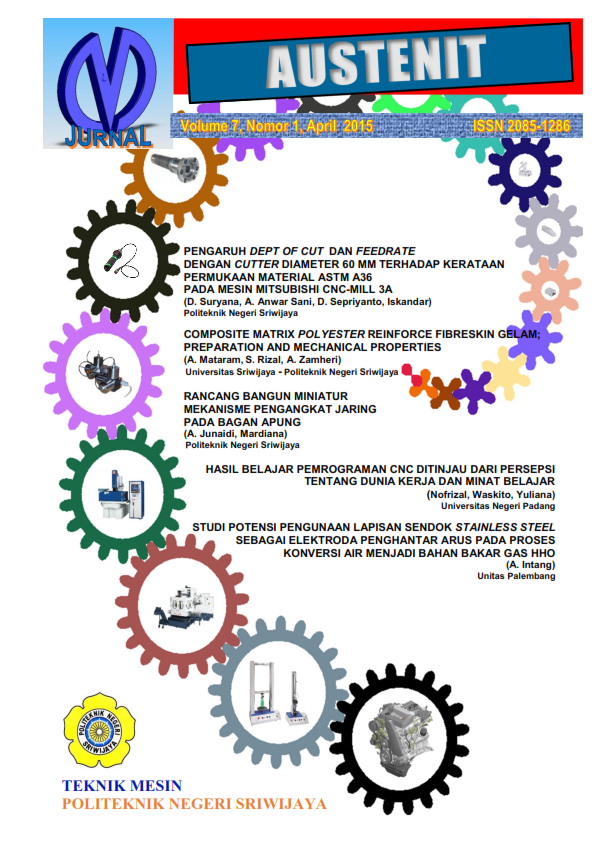COMPOSITE MATRIX POLYESTER REINFORCE FIBRESKIN GELAM; PREPARATION AND MECHANICAL PROPERTIES
Keywords:
Fiberglass, resin, softwood, tensile test, impact testAbstract
Gelam (melaleuca leucandendra) is one plant that is widely available in South Sumatra potential into cellulose extraction. His plant is widely used for building materials and wood products processed the rest of the powder timber furniture industry. While, the skin of this plant is not used for anything. In fact, from the structure of the skin that have fiber, skin of gelam has the potential to be a valuable product, one of them with a matter in the form of composite reinforcement. While today's technology demands urgent environmental friendly technology product makers, especially friendly to the environment. The analysis conducted in this study utilizes softwood bark fiber serves as reinforcement to resin volume fraction ratio : Resin 100% : Filler 0%(A), Resin 90% : Filler 10% (B) Resin 80% : Filler 20%(C), Resin 70% : Filler 30%(D), Resin 60% : Filler 40% (E). Observed characteristics are kekutan composite tensile and impact strength. On average the highest tensile stress is the value obtained from the variation of the volume fraction of the specimen D (70% resin: 30% fiber) that is equal to 17.96 N/mm2, while the average value obtained from the lowest voltage variation of the volume fraction of the specimen B (90 % resin: 10% fiber) that is equal to 12:35 N/mm2. The average value of tensile strain obtained specimens A, B, C, D and E are the same, namely 0.68%. High MOE happens to specimens B, C and E, it indicates that the greater the value of the modulus of elasticity of the material is more difficult to increase the length, in this case the smallest specimen D modulus of elasticity. The average value of the energy required to break the specimen is equal to the highest Joule 34.728, obtained from the variation of the volume fraction of specimen D (70% resin: 30% fiber).Downloads
References
2. Budha Maryanti, A. As’ad Sonief, Slamet Wahyudi, 2011, Pengaruh Alkalisasi Komposit Serat KelapaPoliester Terhadap Kekuatan Tarik. Jurnal Rekayasa Mesin Vol.2, No. 2 Tahun 2011: 123-129.
3. Chandra Setio Budhi, Septa Iriawan, 2008, Studi Pustaka Kinerja Kayu Sebagai Elemen Struktur.
4. Daniel Andri Porwanto, Lizda Johar M ST.MT, Karakterisasi Komposit Berpenguat Serat Bambu Dan Serat Gelas Sebagai Alternatif Bahan Baku Industri, Jurusan Teknik Fisika FTI ITS Surabaya.
5. Dian Monariqsa, Niken Oktora, Andriani Azora, Dormian A N Haloho, Lestari Simanjuntak, Arison Musri, Adi Saputra, Aldes Lesbani, Ekstraksi Selulosa dari Kayu Gelam (Melaleuca Leucadendron Linn) dan Kayu Industri Mebel, Jurnal Penelitian Sains Volume 15 Nomor 3(C) Juli 2002.
6. Fauzi Rahmanullah S. Pd, MT, Agi Arianto Wibowo, 2011, Material Dan Konstruksi.
7. Gibson O.F, 1994, “Principles of Composite Material Mechanicsâ€, McGraw-Hill International Editional Editions, USA.
8. Jonathan Oroh, Ir. Frans P Sappu,MT, Romels Lumintang,ST,MT, 2013, Analisis Sifat Mekanik Material Komposit Dari Serat Sabut Kelapa, Jurusan Teknik Mesin Fakultas Teknik Universitas Sam Ratulangi Manado.
9. Japanese Standards Association. (1980) Japanese Industrial Standar, Test Pieces for Impact Test for Metallic Materials. Japan: Japanese Standards Association.
10. Japanese Standards Association. (1998) Japanese Industrial Standar , Test Pieces for Tensile Test for Metallic Materials. Japan: Japanese Standards association.
11. Laboratorium Metallurgy Jurusan Teknik Mesin Universitas Sriwijaya, "Panduan Pengujian Mekanik dan Metalurgy". 2006
12. Muh Amin, ST., MT, Fu’ad Abdillah, ST, Pemanfaatan Limbah Serat Sabut Kelapa sebagai Bahan Pembuatan Helm Pengendara Roda Dua.
13. Muhammad Ridwan, 2013, Pembuatan Komposit Menggunakan Matrik Limbah Plastik Diperkuat Serat Kaca, Jurusan Teknik Mesin Universitas Sriwijaya.
14. PT. Safina Engineering, Fiberglass Euipment Product, May 2011. http://safinaengineering.com/?p=12
15. Schwartz M.M, 1984, Composite Material Handbook, Mc Graw-will, Singapura.
16. Sinarep, Nasmi Hernila Sari, Ahmad Taufan, 2011, Ketahanan Bending Komposit Hybrid Serat Batang Kelapa/Serat Gelas dengan Matrik Urea Formaldehyde, Fakultas Teknik Universitas Mataram, Mataram.
17. Tumpal Ojahan R, Pengaruh Fraksi Volume Serat Batang Pisang Bermatriks Recycled Polypropylene (RPP) Terhadap Sifat Mekanik Dan Sifat Fisik.
Downloads
Published
How to Cite
Issue
Section
License
The Authors submitting a manuscript do so on the understanding that if accepted for publication, Authors retain copyright and grant the AUSTENIT right of first publication with the work simultaneously licensed under a Creative Commons Attribution-ShareAlike License that allows others to share the work with an acknowledgment of the work's authorship and initial publication in this journal.
AUSTENIT, the Editors and the Advisory International Editorial Board make every effort to ensure that no wrong or misleading data, opinions or statements be published in the journal. In any way, the contents of the articles and advertisements published in AUSTENIT are the sole responsibility of their respective authors and advertisers.















